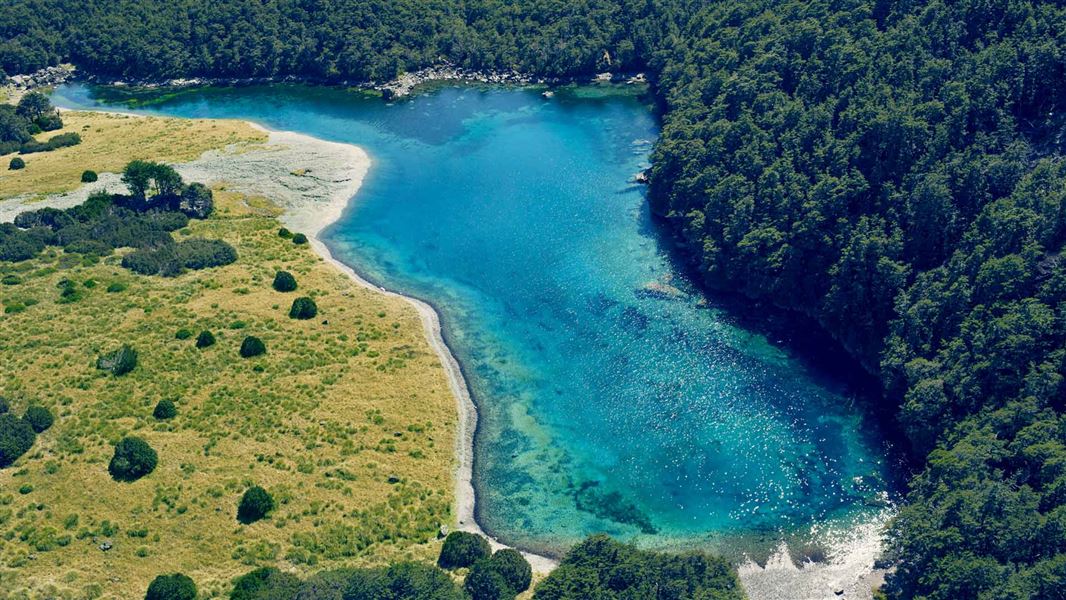Archived content: This media release was accurate on the date of publication.
Date: 11 January 2023
The microscopic alga Lindavia that causes the sticky mucus-like substance known as ‘lake snow’ is in the park’s Lake Rotoiti and Lake Rotoroa. DOC wants to prevent it being spread to Rotomairewhenua/Blue Lake, Rotomaninitua/Lake Angelus and Rotopōhueroa/Lake Constance and to alpine tarns.
Rotomairewhenua is thought to have the clearest freshwater in the world. To help safeguard the lake and other lakes, hut wardens are at the busy Blue Lake Hut over the summer peak visitor season to speak to trampers about preventing the spread of Lindavia and other aquatic pests.
Shep Joice, who grew up in Saint Arnaud, started as DOC Blue Lake Hut Warden in December. Volunteer wardens will also be rostered at the hut until Easter.
Rotomairewhenua and Rotopōhueroa are tapu/sacred to Ngāti Apa ki te Rā Tō iwi, and people are asked not to touch the water in these lakes to uphold their mauri/life force and pureness.
“The Blue Lake hut wardens are talking with visitors about respecting the sacredness of Rotomairewhenua and Rotopōhueroa lakes by not touching the water or swimming in these lakes,” says DOC Community Ranger Sandra Wotherspoon. “People shouldn’t wash or put anything in the lakes, including not filling drink bottles.
“This will also help protect Blue Lake’s outstanding water clarity from being ruined by lake snow.
“Already this summer, there have been up to 50 people staying at the hut and campsite some nights – both international and Kiwi trampers. Shep has been really happy so far with the respect and understanding trampers are showing for the lakes.”
Trampers are asked to make sure all gear has been cleaned and is completely dry before swimming or taking water from Lake Angelus and other tarns. There are no known control or eradication methods for Lindavia, so preventing its spread is a priority.
“As Lindavia is a microscopic organism, it can be spread to a new area in just one drop of water,” says Sandra Wotherspoon. “Clothing, boots, drink bottles and swimming, tramping and fishing gear could harbour Lindavia. It could then be washed out when entering a different lake or river.
“Lindavia is a tricky alga. It floats just below the surface and is hard to detect unless it multiplies in a bloom. When it’s not blooming, people won’t even know there’s contamination though the alga will be present.
“We’re asking people to "Check, Clean, Dry" any clothing and gear that comes into contact with freshwater between every waterway and every waterbody every time in Nelson Lakes and in other areas to protect their water quality and aquatic life.”
Lake snow hangs under the water and can be a nuisance by sticking to fishing gear, boats, motors, and people. It’s not known how Lindavia will affect the ecology and health of the lakes. It is not toxic to humans or livestock and poses no risk from food sourced from the lakes.
Only small amounts of lake snow have been seen in the Rotoiti and Rotoroa lakes to date, with Lindavia having been in the lakes a relatively short time.
Find information on how to clean gear between waterways at the Check, Clean, Dry website.
Background information
Lindavia was brought into New Zealand accidentally and is in a few lakes in Otago, Canterbury and Waikato. In the upper South Island, it was identified in the Buller River in 2019 and then in Lakes Rotoiti and Rotoroa. It is also in Lake Tennyson in Molesworth Recreation Reserve and Nelson’s Maitai reservoir.
NIWA testing found the water clarity at Blue Lake in Nelson Lakes National Park is among the highest in the world, with 63m visibility – optically pure.
Contact
For media enquiries contact:
Email: media@doc.govt.nz
